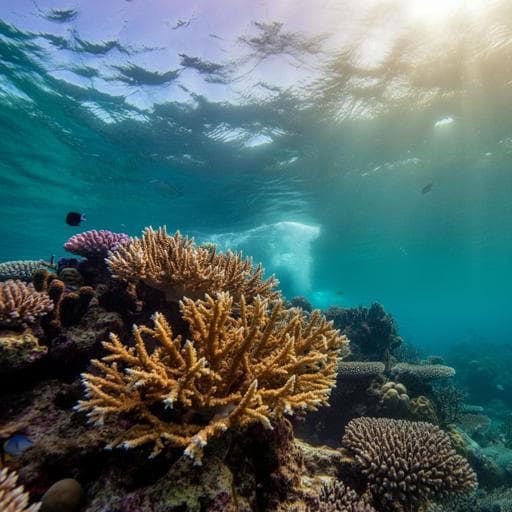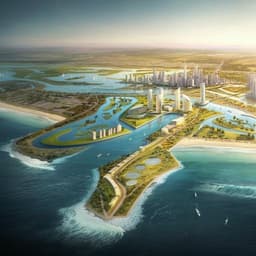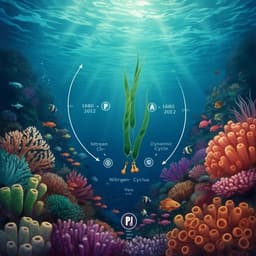
Earth Sciences
The potential for coral reef restoration to mitigate coastal flooding as sea levels rise
L. T. Toth, C. D. Storlazzi, et al.
Discover how coral restoration of *Acropora palmata* could become a game-changer in combating coastal flooding and shoreline erosion. This innovative research conducted by Lauren T. Toth and her colleagues reveals the potential benefits of revitalizing our reefs to better adapt to climate change.
~3 min • Beginner • English
Introduction
Climate change is degrading coral reefs and raising sea levels, threatening reefs’ ability to dissipate wave energy and protect coastlines. Losses of key reef-building corals, decreased reef elevation and structural complexity, and bioerosion reduce vertical accretion capacity, especially at the reef crest—the primary zone of wave dissipation and shoreline protection in the western Atlantic. Historically dominated by Acropora palmata, reef crests have flattened and deepened following disease and thermal stress-driven declines of A. palmata over recent decades. The study asks whether large-scale restoration of A. palmata can reverse erosion trajectories, increase reef accretion sufficiently to keep pace with projected sea-level rise, and thereby mitigate storm-driven coastal flooding. Using Buck Island Reef National Monument (BIRNM), U.S. Virgin Islands, as a case study, the authors integrate carbonate-budget assessments, in situ coral-growth measurements, and hydrodynamic modeling to quantify how restoration and sea-level rise scenarios influence future coastal flooding risk by 2100.
Literature Review
Prior work shows coral reefs reduce coastal hazard risk by dissipating wave energy; however, degradation from climate change, disease, and human impacts reduces complexity and accretion capacity, increasing flood risk. Modeling studies indicate increased water depths over reefs amplify coastal flooding, and regional studies document divergence between seafloor elevation and sea-level rise. Western Atlantic reefs lack broad reef flats common in the Indo-Pacific, making reef crests critical for protection. Historic dominance and rapid growth of A. palmata supported high Holocene accretion rates, but white-band disease and bleaching drastically reduced its cover. Carbonate budgets provide a framework to estimate accretion-erosion balances and evaluate management actions like restoration, yet few budgets include high-energy reef crests. The study builds on this literature by combining crest-inclusive carbonate budgets with hydrodynamic modeling to directly assess coastal protection outcomes under restoration and sea-level rise scenarios.
Methodology
Study area: Buck Island Reef National Monument (BIRNM), St. Croix, U.S. Virgin Islands, with a narrow emergent barrier reef (∼10 m wide) enclosing a 1–4 m deep lagoon.
- Carbonate budgets (2016): 54 stratified-random sites (n=18 each in fore-reef, reef-crest, back-reef habitats; equally split between northern/leeward and southern/windward sectors). Benthic cover quantified from photo-transects (10×1 m, CoralNet). Gross carbonate production estimated using ReefBudget v1 taxon-specific calcification and rugosity corrections; bioerosion estimated from fish (seven parrotfish species via belt transects and size/life phase-specific rates), sea urchins (four species, size-based rates with a 0.57 sediment reingestion factor), and endolithic macro- and microbioeroders (site-level rates scaled by dead substratum cover). Net carbonate production converted to vertical accretion/erosion using framework density/porosity and local Holocene core-derived fractions of sediment (33%), void (18%), and framework (49%). Projected elevation change to 2100 derived by applying site/zone accretion potentials over 84 years to 2014 USGS lidar bathymetry, producing modified bathymetries by sector and habitat. Statistical analyses used linear mixed-effects models (sector and habitat fixed effects; site random intercept), ANOSIM, and SIMPER.
- Coral growth experiment (2019–2021): In situ growth and calcification of A. palmata (branch tips from five mother colonies; 30 colonies included) and Pseudodiploria strigosa (30 colonies) transplanted onto fixed mounts at three locations. Measured twice per year for two years using buoyant weight; changes in height and planar area recorded to normalize calcification.
- A. palmata restoration population model: Matrix model (no sexual reproduction) projecting percent cover on reef crest (area 166,407 m²) under outplanting scenarios of 100,000, 250,000, and 500,000 colonies (≈0.6, 1.5, 3.0 ind m⁻²) during 2020–2030, with an initial decade of growth 2030–2040. Mortality scenarios per decade: fixed net survival 60% (based on 3% long-term survival combined with 55% net fragmentation), increasing climate impacts (+5% mortality per decade), or decreasing impacts (−5% mortality per decade). Converted modeled colony areas to percent cover assuming no overlap and confinement to crest habitat.
- Restoration-augmented carbonate budgets: Re-ran budgets with hypothetical increases of A. palmata cover from +5% to +30% (5% steps), using the local mean A. palmata calcification rate (29.07 kg CaCO3 m⁻² y⁻¹) for conservative estimates.
- Hydrodynamic modeling: 2D XBeach surfbeat model with curvilinear grid (cross-shore 4–40 m; alongshore 9–50 m), 2014 lidar topo-bathymetry, spatially varying roughness. Validated against observed wave event (Jan 13, 2016) using SWAN boundary conditions (ERA5 winds/waves), with good agreement in water levels and wave components at four sites. Scenarios: sea-level rise +0.0, +0.2, +0.5, +1.2, +2.0 m; storms corresponding to 10-year (Hs=4.01 m, T=15.8 s, surge +0.37 m) and 50-year events (Hs=4.78 m, T=18.7 s, surge +0.64 m), both from 65° direction and added to MHHW 0.40 m for 1 h simulations. Ran with present and projected 2100 bathymetries (erosion/accretion). Extracted shoreline maximum total water levels (tide + surge + sea-swell and infragravity contributions). Restoration effect approximated by subtracting projected crest elevation increase for +30% A. palmata from sea-level scenarios (linear interpolation; floored at +0.0 m SLR levels when crest exceeded sea level).
Key Findings
- Baseline carbonate budgets (2016): Reef-accretion potential ranged from −5.31 to 6.21 mm y⁻¹ (mean −1.56 ± 0.27 mm y⁻¹; n=54). Only 5 sites were positive; bioerosion dominated at 91% of sites. Southern reef crest was the only zone with marginally positive mean accretion potential (0.10 ± 1.20 mm y⁻¹; other zones ≤ −1.41 mm y⁻¹). Sector effect significant (LME sector F1,16=5.72, p=0.03). Projected elevation change by 2100: southern reef crest ~+1 cm (±10 cm; negligible), other zones average −13.09 cm (±0.02). Bioerosion primarily driven by Sparisoma viride; bioerosion did not differ significantly among sectors/habitats. Higher coral cover on southern crest (14.88% ±4.05 vs <7% elsewhere) increased gross carbonate production (3.43 ±1.20 vs ≤1.70 kg CaCO3 m⁻² y⁻¹); sector and sector×habitat effects significant (F1,16=7.58, p=0.01; F2,32=3.92, p=0.03; Tukey p<0.05 for southern crest vs multiple zones).
- Coral growth (2019–2021): A. palmata calcification 21.04–42.91 kg m⁻² y⁻¹ (mean 29.07 ±1.26); height increase 6.99 ±1.56 cm y⁻¹ (4.19–9.25); planar area +196.21 ±102.95 cm² y⁻¹ (51.67–407.80). Early thermal stress caused 14/30 transplants to die within days; only one additional death over two years. Pseudodiploria strigosa calcification 7.96–21.31 (mean 14.30 ±0.86) kg m⁻² y⁻¹; height +0.95 ±0.71 cm y⁻¹ (−0.50 to 2.70); area +12.88 ±9.71 cm² y⁻¹ (−5.10 to 35.45); survival high (4 complete, 4 partial mortalities), SCTLD appeared late.
- Restoration population model (A. palmata): A single, large-scale outplanting before 2030 increased crest cover by 8.5% (100k), 21.2% (250k), and 42.4% (500k) under fixed 60% decadal survival. Without additional outplanting or reproduction, cover gradually declined after ~2050; declines were fastest with increasing mortality scenarios. Optimistic cases (e.g., reduced mortality with 500k or fixed mortality with 500k) retained >10% net increase to 2100; best case maintained >30% increase to 2100.
- Restoration impacts on accretion: With +30% A. palmata cover (to ~36% north, 45% south total cover), crest accretion potential averaged 7.38 ±0.60 mm y⁻¹ (6.59 ±0.70 north; 8.16 ±0.94 south), enabling ~0.25 ±0.02 m vertical accretion by 2050 and ~0.62 ±0.05 m by 2100 (0.55 ±0.06 north; 0.68 ±0.08 south). Scenarios with <25% increase were insufficient to keep pace with even low-end sea-level rise.
- Hydrodynamics and flooding: With present bathymetry, spatially averaged maximum total water levels’ wave-driven component was 4.17 ±0.03 m (10-year storm) and 4.94 ±0.02 m (50-year storm). Total water levels increase non-linearly with sea-level rise as larger waves propagate across deeper reefs; alongshore variability decreases as depth increases. Northern sector experiences higher future water levels due to greater projected reef erosion. Successful restoration (+30% cover) could reduce total water levels by up to 0.81 ±0.03 m on average under intermediate-to-high SLR and effectively downgrade flooding from a 50-year (major hurricane) event to levels akin to a 10-year (strong tropical storm/Category-1) event.
- Cost context: Restoring the 166,407 m² crest could cost ~$6.6M (at ~$400k USD ha⁻¹), and 500,000 A. palmata outplants at ~$25 each ≈ $12.5M; potential benefits include avoided damages and protection of cultural/ecological resources.
Discussion
The study demonstrates that while sea-level rise will be the dominant driver of future coastal flooding, ongoing reef erosion further amplifies risk—especially where reef crests have lost elevation and complexity. At BIRNM, most sites are already net erosional, with only the southern crest marginally positive due to remnant A. palmata and massive coral cover. Empirical growth data confirm A. palmata can grow vertically fast enough to match even pessimistic sea-level rise rates, and modeling shows that if restoration increases A. palmata cover by ~30% on the crest, accretion could keep pace with low to intermediate-low sea-level rise by 2100. Hydrodynamic simulations show that the resulting increase in crest elevation and roughness substantially reduces wave-driven water levels, mitigating storm flooding and potentially lowering the severity of flooding from major hurricanes to levels typical of minor storms. These findings indicate that targeted, large-scale restoration can help maintain the coastal protection function of reefs when combined with broader climate mitigation to limit sea-level rise. The results also highlight spatial heterogeneity—greater erosion and flooding potential in the northern sector—and the need for site-specific strategies to optimize protection of vulnerable shorelines and resources. The work provides a quantitative framework linking restoration targets (e.g., +30% A. palmata cover) to functional outcomes (keeping pace with ~0.5 m sea-level rise, reducing total water levels by up to 0.81 m).
Conclusion
This study links carbonate-budget assessments, in situ coral growth, and hydrodynamic modeling to quantify how restoration of Acropora palmata could mitigate coastal flooding as sea levels rise. At BIRNM, current reef accretion is insufficient and most sites are net erosional; however, restoring A. palmata to increase crest cover by ~30% could raise accretion rates (~7.4 mm y⁻¹) enough to keep pace with low to intermediate-low sea-level rise (~0.5 m by 2100) and reduce storm-driven total water levels by up to 0.81 m. Restoration at this scale could downgrade flooding impacts from major to minor storm equivalents. Achieving these benefits likely requires substantial near-term investment, improvements in coral resilience or reduced mortality, and ideally reestablishment of self-sustaining, reproductive populations. Future research should refine site-specific restoration targets with updated carbonate-budget methods, incorporate physical erosion and dissolution more explicitly, evaluate hybrid approaches combining engineered structures with ecological restoration, and conduct long-term monitoring to track realized accretion and coastal protection outcomes under evolving climate and disturbance regimes.
Limitations
- Carbonate-budget estimates represent optimistic, maximum accretion potential and omit explicit physical erosion (e.g., storm damage) and chemical dissolution; realized accretion may be substantially lower.
- Storm frequency and intensity may increase with climate change, potentially elevating erosion beyond modeled expectations.
- Restoration population model excludes sexual reproduction (likely low at present) and simplifies fragmentation and mortality dynamics; storm-driven fragmentation not explicitly modeled.
- Hydrodynamic modeling approximates restoration-induced elevation changes by adjusting effective sea level rather than fully resolving altered roughness/geometry in a dynamically updated reef structure.
- Affordability and logistics: Large-scale restoration costs and operational feasibility may constrain implementation; outcomes depend on improving coral survival/resilience.
- Site-specificity: Results are most applicable to BIRNM’s ecological/geomorphic context; other locations may have different bioerosion rates, legacy deficits relative to sea level, and bathymetry.
- Methodological updates (ReefBudget v2) could alter carbonate budget estimates; however, available evidence suggests original estimates may be conservative for accretion potential and high for bioerosion.
Related Publications
Explore these studies to deepen your understanding of the subject.







